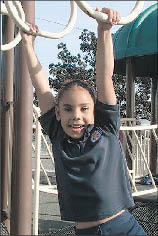 |
| Photo: Photo courtesy of SAY |
San Diego—It took just a few days for Michael Carr to learn the cold realities of working for a youth-serving nonprofit.
The former pastor moved from Connecticut back to his native San Diego in the mid-1970s, hoping to get into neighborhood-based social services. He thought he found a perfect fit as a program director at Social Advocates for Youth (SAY) San Diego.
“I was working for about a week,” he says, “when I was told: ‘Incidentally, we only have funding for about three months.’ ”
Carr quickly learned how to raise money, and learned well: Today he runs the agency, overseeing a staff of 500 and a budget of $16 million, up from $207,000 when he arrived. While SAY began by serving adjudicated youth, it has grown by shifting its juvenile justice work to a prevention approach and by developing fee-based after-school programs that bring in $1.7 million a year.
 |
|
Carr: “We’re going to surround the kid and say, ‘Together we’re going to make this work.’ ” |
SAY has become “one of the top four or five primary youth-serving organizations here,” says Walter Philips, executive director of San Diego Youth and Community Services, which focuses on homeless, runaway and abused youth and sometimes collaborates with SAY.
Its growth shows how a nonprofit can adapt to changes in demographics, funding and need while staying true to its mission. SAY aims to keep at-risk youth out of the juvenile justice system by identifying kids with behavioral problems early and by working with them, their families and important adults in their communities. It serves about 35,000 youth and families through 60 before- and after-school programs and five multi-service Family Resource Centers.
“We’re going to surround the kid and say, ‘Together we’re going to make this work,’ ” Carr says.
Shift
SAY was founded in 1971 in Linda Vista by Richard Schear, who had strong ties to the local Catholic community. (It is not affiliated with other Social Advocates for Youth organizations around the country.) The agency worked mostly with adjudicated kids, helping them through the courts and probation.
“It was a lot of handholding,” says Carr, a soft-spoken 59-year-old.
Carr had done his seminary studies in New York and served as a pastor in England. He edged into the social services side of church work with the United Church of Christ in Hartford, Conn.
When he returned home to San Diego in 1977, he found that churches weren’t funding social service programs. Then someone told him about SAY, where “finding the money was something I had to do very early on,” he says. He became executive director in 1980.
SAY received funding from a variety of typical sources – the city, county and donors such as the local Junior League.
Then an elementary school asked SAY if it would do something new: Take over an after-school program, because the original provider bowed out in mid-year. SAY gave it a try. “Lo and behold, we actually made a small profit,” Carr says.
Seeing the potential to earn income and to help kids stay out of trouble by providing homework and recreation help, SAY set out in 1983 to run more after-school programs in elementary and middle schools. The programs ran at both low-income schools and schools where most parents could afford to pay fees, with SAY using the money from the latter to fund the former.
“It helped us make money early on,” Carr says. SAY reports that its budget grew from $631,000 in 1982-83 to $1.7 million by 1990. SAY now runs 11 fee-based after-school programs.
Another avenue for new services opened in the early 1990s, growing out of collaborations among SAY and other community-based groups that realized “we could not solve the problems that we faced alone,” Carr says. Those collaborations led to the concept of the Family Resource Centers, which are located with other agencies in high-need neighborhoods. The centers offer kids and their parents a variety of services under one roof, including parenting classes, substance abuse counseling, tax preparation and family budgeting, and referrals for health care. SAY opened its first center in 1994, with funding from the California Office of Child Abuse Prevention.
By then, San Diego was going through significant changes that would spur further changes at SAY. The city’s population, cost of living and juvenile crime were all soaring.
“Juvenile Hall was overflowing,” says Derryl Acosta, spokesman for the San Diego County Probation Department.
One reason: The county had no special way to handle first-time youth offenders who committed minor crimes; they were treated the same as serious repeat offenders. “It became apparent that we needed h
 |
elp from the community” to craft a different approach, Acosta says.
Building Teams
In the late 1990s, agencies such as SAY, along with businesses and the county departments of probation and mental health, hashed out a comprehensive juvenile justice strategy, with a new focus on prevention. The strategy resulted in several countywide initiatives, including Community Assessment/Working to Insure and Nurture Girls’ Success (Ca/Wings), funded by the state’s Juvenile Justice Crime Prevention Act, enacted in 2000.
The act’s annual funding of $119 million supports 168 programs in 56 counties, serving 105,000 at-risk youth. SAY is one of five agencies in San Diego that run Ca/Wings programs, getting about $1.4 million of that money, Carr says.
The Community Assessment Team (CAT) and Wings both target 6- to 17-year-olds with behavioral problems who are on probation or appear to be heading there. Youths are referred to the programs by various sources, including youth workers, parents, probation officers and teachers. At the Mid-City Family Resource Center, the typical charges for girls referred by probation officers are theft, drug possession and battery against their mothers or siblings, said Vikki Bouck, the Wings program coordinator there.
The services include home-based and peer-group counseling, tutoring, career planning and financial skills coaching. The key is to form a team around each youth, made up of important people in that youth’s life.
“Maybe it’s your Uncle Jerry, who’s important to you. Maybe it’s your soccer coach. Maybe it’s the teacher who made the referral,” Carr says. The team also includes parents and SAY staff.
The team develops goals and strategies for the child and the family, such as improving school attendance and grades, stopping drug use or attending therapy for depression. Teams meet at various places, including SAY facilities and the youths’ homes.
“Once we drag that soccer coach in, that soccer coach begins to understand that he or she has a role in influence and prevention,” Carr says. “We expand the number of people at the community level who understand they are part of the solution.”
That solution typically involves helping the parents with their problems, too. “We customarily have family goals that the parents have to work on, as well as the kid,” Carr says.
Mid-City reports that its Wings program sees about 1,100 youth and adults a year from communities around the city, and that about 350 youth become case-managed, which means they get more comprehensive services.
Changing Challenges
Because of SAY’s adaptation over the years, today “it’s hard to pigeonhole them” as primarily a juvenile justice or after-school agency, says Philips at San Diego Youth and Community Services. And the agency will have to continue adapting to changes in local needs, some of which are extreme versions of challenges faced by many youth programs around the country.
The population of the San Diego region increased 9 percent from 2000 to 2006, to 3 million people, according to the San Diego Association of Governments. “It’s a scarier, more complex town and society,” Carr says.
As a border town, San Diego serves a growing Hispanic immigrant population, many of whom are undocumented aliens. Helping them can be a touchy issue; some of SAY’s funders prohibit the organization from using their money to provide services to undocumented immigrants. On the flip side, some illegal immigrants are wary of seeking help, for fear of being reported to authorities.
A newer twist is the increase in help needed by military families, whose problems stem largely from the wars in Iraq and Afghanistan. “We’re seeing a lot of depressed moms,” Carr says. “We see these kids acting out like crazy.”
As in most large American cities, poverty is at the root of many social ills here. About 13 percent of San Diego’s workforce earned less than $8.35 per hour in 2006, according to the San Diego Association of Governments.
That means that for many residents, the $472,000 median home price (according to the San Diego Housing Commission) is way beyond reach. The rental picture isn’t much better: Average monthly rents increased 5.8 percent in 2006, to $1,237 – nearly double the average rent in 1992, according to the housing commission.
Success
It’s difficult to tell whether SAY affects juvenile crime. Juvenile arrests declined annually from 1999 to 2006, to a current arrest rate of 49.4 per 1,000, according to the San Diego Association of Governments. However, Acosta at the Probation Department points to the difficulty of trying to draw a correlation between prevention programs and overall crime in a community. “There are so many other factors,” he says.
There is some evidence that the county’s Ca/Wings programs have some impact, at least short term. Last year, more than 90 percent of youth in the programs around the county accomplished all or some of their goals or demonstrated improvement in behavior, said Darlanne Hoctor Mulmat, who evaluates Ca/Wings annually as an associate research analyst at the San Diego Association of Governments.
As for its financial success, SAY continues looking for new ways to make money. Developing more corporate support is one area for improvement. “We haven’t done a very good job at that,” Carr says.
But asking corporations for donations “isn’t the best way,” he says. He prefers to raise corporate money through events like Biz Bee, a popular corporate spelling bee for adults. Companies paid a sponsorship fee to compete against each other.
“It got real intense. People really wanted to win,” Carr says.
Carr also is expecting some new funding for health care. “We’re seeing a lot of funding coming down that is talking about health disparities” among different demographic groups, he says. SAY could use that money to add health care promotion to its resource centers.
At least he doesn’t have to worry about SAY going bankrupt in three months. It reports $2 million in assets.
Carr doesn’t seem to mind the financial demands of being a nonprofit businessman. As he says, “If you can’t run the business side, if you can’t stay in business to do the work, you fail.”
Contact: SAY (858) 565-4148, http://www.saysandiego.org.





























